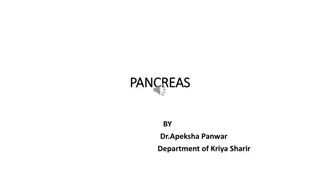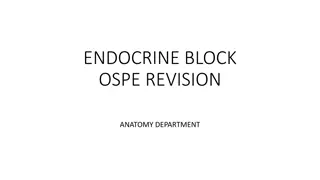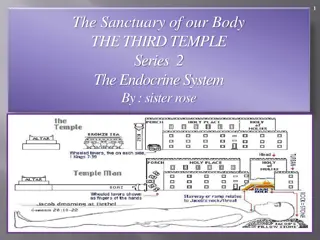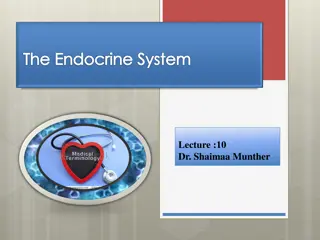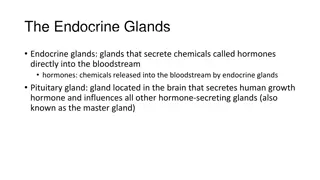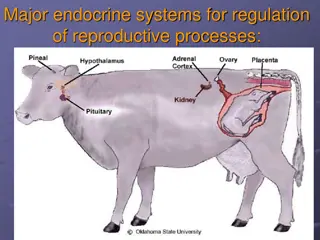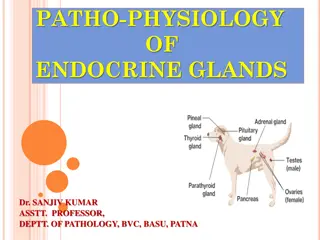the Endocrine System
The endocrine system comprises various glands that release hormones into the blood, regulating growth, development, behavior, and reproduction. Learn about the major endocrine glands like the pituitary, thyroid, parathyroid, adrenal, pancreas, and sex glands and their functions in the body. Explore the roles of hormones in maintaining overall health and balance within the body.
Uploaded on Apr 19, 2025 | 0 Views
Download Presentation

Please find below an Image/Link to download the presentation.
The content on the website is provided AS IS for your information and personal use only. It may not be sold, licensed, or shared on other websites without obtaining consent from the author.If you encounter any issues during the download, it is possible that the publisher has removed the file from their server.
You are allowed to download the files provided on this website for personal or commercial use, subject to the condition that they are used lawfully. All files are the property of their respective owners.
The content on the website is provided AS IS for your information and personal use only. It may not be sold, licensed, or shared on other websites without obtaining consent from the author.
E N D
Presentation Transcript
GOOD GOOD AFTERNOON AFTERNOON TO ALL TO ALL
Endocrine System: The endocrine system consists of a number of glands, which release substances, called hormones into the blood. Hormones act as chemical signals throughout the body, functions in the body. Each hormone is required in every small quantity and has its own specific functions. Hormones produce slower and generally lasting responses. Hormones development, behaviour and reproduction. The major endocrine glands that produce hormones are located in various parts of the body. which regulates many control growth,
Types of Gland: The Pituitary Gland Cranial cavity (base of the brain) The Thyroid gland Neck The Parathyroid Gland Neck (back of thyroid gland) The Adrenal gland At the top of each Kidney The Pancreas Behind the stomach The Sex Glands Pelvic Cavity
The Pituitary Gland: The pituitary gland also called as hypophysis which is a small marble sized oval body weighing about 0.5 grms. It is also called Master gland because it secretes a number of hormone which affect the other glands and organs. The pituitary gland is located at the base of the brain and is connected with the hypothalamus in the brain. Function: It promotes growth development of all body tissues through maturation. It increase rate of protein production. It increases mobilization of fat and used of fat as an energy source. It promotes growth of bones and muscles. It promotes release of hormones from adrenal and thyroid glands. It helps in development of female and male sex. It stimulates breast development and milk secretion.
The Thyroid gland: The thyroid gland is located in the neck just below larynx and weight about 30 to 60 grms. It consists of right and lobes connected by isthmus. The malfunctioning of thyroid gland give rise to the disease called goiter. Functions: Thyroid hormone regulates the rate of metabolism, which take place in cells to produce energy. It helps in regulating calcium metabolism. It increases rate and contraction ability of the heart.
The parathyroid gland: The parathyroid glands are attached to the back of the thyroid glands. These are small round bodies usually 4 to 5 in numbers each weighing 0.05 grms. Function: Parathyroid hormones increases blood calcium by stimulating bone break down. It releases calcium and phosphate into the blood from bones. It fastens kidney excretion of phosphate from blood into urine. It also increases blood calcium by increasing calcium absorption from intestine and kidney. Excessive creation of parathyroid hormone causes decrease in bone mass. Lower creation of parathyroid hormone causes death in few hours.
The Adrenal Gland: The Adrenal glands are located directly at the top of each kidney. The Adrenal are a paired organ each adrenal weigh about 12 grms and is triangular shaped. Each adrenal gland has two portions i.e. outer called cortex and inner called medulla. Function: The Adrenal hormone increase skeletal muscle blood flow. It increases heart rate and contraction ability of heart. It increases oxygen consumption. It elevates blood pressure. It control metabolism of carbohydrates, fats and protein. It helps in the development of female and male sex qualities.
The Pancreas: The pancreas is located behind and slightly below the stomach. The two major hormone of pancreas are insulin and glucagon. Function: Pancreas hormones control blood glucose level by lowering glucose levels. It increases use of glucose and synthesis of fat. It stimulates the breakdown of fat and protein. It increases gastric secretions. It also functions in distribution of nutrients to the tissues and cell or metabolism
The Sex glands: The sex glands, the testes and ovaries are reproductive glands. These glands internally secrete sex hormones that are delivered into the blood. The testes and ovaries are reproductive organs of male and female respectively. Functions: Testes hormone promotes development of male sex characteristics including growth of testes, scrotum and penis, facial hair, change of voice. It also promotes muscle growth. Ovaries hormones promote development of female sex organs and characteristics. It provides increased storage of fat. It helps in regulation the menstrual cycle in female.


